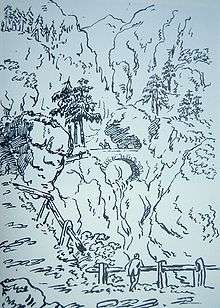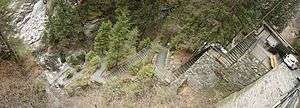Viamala
Viamala or Via Mala (which in Romansh literally means "bad path") is an ancient and notorious section of a path along the river Hinterrhein between Zillis-Reischen and Thusis in the Canton of Graubünden. This narrow gorge was the most serious obstacle on the approach to two mountain passes: the Splügen and the San Bernardino.
| Viamala | |
|---|---|
 Viamala with the two generations of bridges visible | |
 | |
| Floor elevation | approx. 842 metres (2,800 ft) |
| Length | 5 kilometres (3.1 mi) |
| Width | 0.5 to 0.006 kilometres (0.3107 to 0.0037 mi) |
| Geography | |
| Location | Graubünden |
| Coordinates | 46°39′46″N 9°26′56″E |



History
Antiquity
There was a path through the Viamala already in Roman antiquity, though it is not clear whether it was only a foot and bridle path, or could also be used by wagons. Two access paths met at the northern entrance to the Viamala, which the Romans traversed by means of several rock galleries cut into the walls on the left side of the gorge. Presumably somewhere below today's automobile bridge and near the pedestrian bridge (Punt da Suransuns) the Romans constructed a wooden bridge crossing over to the right side of the Rhine, routing traffic via Reischen to Zillis.
1473 Viamala letter of intent
During the medieval period more and more of the transit traffic (vital for the region) was conducted via the Septimer Pass instead of the Splügen Pass. This was supported by Charles IV, Holy Roman Emperor, who forbade the local Count of Werdenberg to build a new path in 1359 in order to support the loyal Bishop at Chur, who controlled the route via the Septimer Pass.
In 1473 the Count of Werdenberg allowed the municipalities and transport cooperatives of Thusis, Masein and Cazis to rebuild the passage, then in desolate condition: die richstrass und den waeg entzwüschend Tusis und Schams, so man nempt Fyamala zuo howen, uffzuorichten und ze machen.[1] The Roman part of the path built into the rock was renovated and the first bridge built of rock, Punt da Tgiern, was erected. The last part of the letter mentions that the cooperatives would be accountable for loads, horses and also a “chariot or sled”, which indicates a high level of technical finishing. In the northern part of the gorge this new path did not follow the Roman path crossing to the right of the river, but stayed on the left river bank. This led to many conflicts during the years as the two villages at the respective ends of the path fought for access and the resulting income. In 1665 Schams was temporarily excluded from the Grey League for supporting the path towards Fürstenau, which led to non-Grey-League territory.
Modern era
During 1738–1739 two bridges were built to twice cross the river and avoid the worst part of the Roman path via the right bank of the river. Later, state engineer Richard La Nicca built a completely new road during 1818–1821 including more tunnels and connecting the three existing bridges. The access to the 1473 rock bridge Punt da Tgiern was destroyed in 1834, leaving the unhurt bridge useless and left to disintegrate. In 1836 the new Rania Bridge was erected instead further north and is still being used today for the main road.
An additional bridge called Premoli Bridge was constructed in 1936 to relieve the southern 1738 bridge, which is still in place and can be crossed by foot. The northern bridge of 1738 was replaced two years later, with no traces remaining.
In 1958 a new northern part of the road to Rongellen was built using longer tunnels, and in 1967 a new expressway was opened including the San Bernardino Tunnel and allowing year-round traffic (whereas both road passes were closed in winter). This road uses a 742 m long tunnel to avoid the narrow gorge and crosses the gorge on a long stretch bridge in its southern part. Finally, the part built in 1958 between Thusis and Rongellen was replaced by a 2171 m long tunnel called the Crapteig in 1996.
To connect the visible remains of the Roman path, a pedestrian bridge named the Traversinersteg was erected in 1996.[2] This bridge was destroyed in 1999 and replaced by a (safer) bridge in 2005, which is at the same time a bridge as well as a stairway.
The Via Mala was used by the German film director Werner Herzog as a location in his 1976 film Heart of Glass.
Literature
- Armon Planta: Verkehrswege im alten Rätien Band 4. Verlag Bündner Monatsblatt, Chur 1990. ISBN 3-905241-06-4
- Friedrich Pieth: Bündnergeschichte. 2. Auflage. Verlag F. Schuler, Chur 1982. ISBN 3-85894-002-X
References
External links
| Wikimedia Commons has media related to Via Mala. |